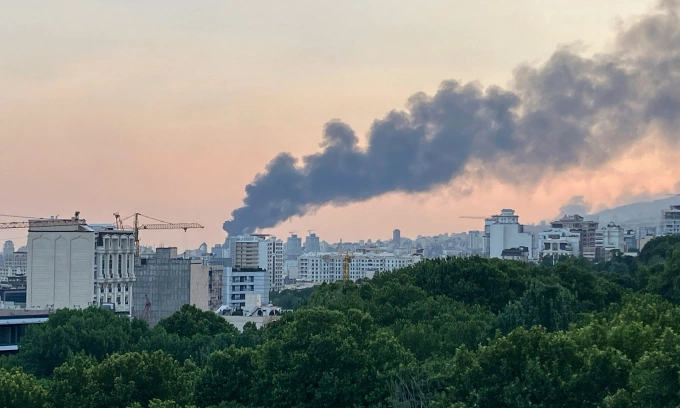
Mutual Destruction Risk Drove Israel and Iran Toward Ceasefire
After suffering heavy losses in a 12-day exchange of missile and air strikes, both Israel and Iran agreed to a ceasefire brokered by U.S. President Donald Trump, driven by the growing risk of mutual destruction.
On June 13, Israel launched Operation Rising Lion, targeting Iranian nuclear facilities, military bases, and senior leadership in one of the most aggressive escalations between the two regional powers in decades. Iran retaliated with a barrage of ballistic missiles and drones targeting major Israeli cities, including Tel Aviv and Haifa.
The back-and-forth assault marked a critical stress test on both nations' military, political, and economic resilience. But as the conflict dragged on, resources dwindled, international pressure mounted, and the risk of wider regional escalation became unavoidable. The realization that neither side could win a prolonged war without catastrophic consequences ultimately drove both countries to accept Trump’s ceasefire proposal on June 24.
Military Toll
The 12-day confrontation was a war of attrition, where both sides deployed their most advanced and expensive weapons systems to inflict maximum damage while defending key infrastructure.
Israel deployed hundreds of fighter jets in an effort to dominate Iranian airspace. The Israel Defense Forces (IDF) claimed to have destroyed nearly half of Iran’s ballistic missile launchers and several air defense systems, resulting in over 600 Iranian deaths and more than 5,000 injuries.
However, the IDF failed to destroy Iran’s Fordow nuclear facility, buried deep in a mountain and often dubbed Iran’s “nuclear fortress.” The U.S. stepped in with 12 bunker-busting GBU-57 bombs, but intelligence from the Pentagon’s Defense Intelligence Agency (DIA) indicated the strike may have only set back Iran’s nuclear program by a few months.
Iran, despite sustaining major damage, continued launching Emad, Ghadr, and Kheybar-class ballistic missiles. In just under two weeks, Iran fired more than 550 ballistic missiles and nearly 1,000 drones at Israeli targets.
Israel’s multi-layered air defense system, including Iron Dome and David’s Sling, initially intercepted 85–90% of incoming threats. But over time, interception rates dropped, and several Iranian missiles struck populated areas, killing at least 28 civilians and injuring over 2,500.
By June 18, U.S. intelligence warned that Israel might only have 10–12 days’ worth of missile defense interceptors left without immediate resupply from Washington.
Meanwhile, Iran’s strike capabilities also began to dwindle. According to military analyst Tom Karako, Iran’s missile reserves were rapidly depleting, and it became increasingly difficult to replenish them. In the final days of the conflict, Iran was firing only a handful of missiles per round—down from over 100 in early barrages.
Economic Fallout
The fighting took a serious economic toll on both nations. In Iran, Israeli strikes on fuel depots and energy infrastructure in Tehran led to fuel shortages, deepening the crisis in an already sanctions-stricken economy.
The International Monetary Fund projected Iran’s inflation rate could soar to 43.3% this year, up from 32.6% in the previous year.
“The sanctions have eroded Iran’s middle class. With inflation and stagnating wages, poverty is deepening,” said Mohammad Farzanegan, a Middle East expert at Germany’s University of Marburg.
If the war had continued, Iran’s critical infrastructure—transportation, communications, and logistics—would likely have faced widespread collapse. Some experts warned that a move like closing the Strait of Hormuz, though capable of spiking global oil prices beyond $100 per barrel, would have also backfired on Iran’s own economy, which depends heavily on oil exports.
Israel, with a stronger economy, still faced massive financial strain. Iranian missile strikes disrupted commercial activity in key cities, and the cost of operating its missile defense systems was staggering. According to financial publication The Marker, Israel spent an estimated $285 million per night defending against missile attacks.
Economists estimate Israel could endure a short war with Iran, but a prolonged conflict—lasting a month or more—could cost the country over $12 billion.
Political and Social Pressure
The war put immense pressure on both governments. International calls for de-escalation grew louder. UK Prime Minister Keir Starmer emphasized the need for stability in the Middle East, while UN Secretary-General António Guterres urged both parties to show “maximum restraint.”
While Trump backed Israel militarily, he rejected plans to assassinate Iran’s Supreme Leader Ayatollah Ali Khamenei, expressing a desire to avoid deeper entanglement in Middle Eastern conflicts.
Domestically, Israeli Prime Minister Benjamin Netanyahu faced growing discontent over civilian casualties and vulnerabilities in national defense. Repeated air raid sirens forced Israeli citizens into bomb shelters nightly, and images of apartment buildings reduced to rubble intensified public anxiety.
In Iran, relentless Israeli airstrikes pushed many residents to flee major cities, while high-profile assassinations of Iranian generals and nuclear scientists eroded public confidence in the regime’s ability to protect its own.
Commentators at Al Jazeera noted that both nations understood the long-term risks of an extended war, particularly under the burden of domestic economic hardship and public unrest.
“It became clear to both sides that a prolonged conflict would end in mutual ruin,” said Trita Parsi, vice president of the Quincy Institute for Responsible Statecraft in Washington. “That’s why, when Trump gave the green light, both sides moved quickly to accept the ceasefire.”
(Sources: Economist, Washington Post, Associated Press)
Hello Shuttle will strive to bring the latest updates. At the end of the day.
Are you looking for reliable airport and cruise port transfer services in Los Angeles?
We offer professional, safe, and punctual transportation from
Los Angeles Airport - LAX
Long Beach Airport - LGB
John Wayne Airport - SNA
San Pedro cruise port
Long Beach cruise port
Disneyland
and other destinations.
Let us make your journey stress-free and comfortable with our dedicated drivers and high-quality vehicles. Book now for the perfect travel experience at www.helloshuttle.com or call 944-800-5678!


